2 新疆维吾尔自治区文物考古研究所, 新疆 乌鲁木齐 830011;
3 兰州大学历史文化学院, 甘肃 兰州 730000)
石城子遗址地处新疆天山北麓的奇台县,不仅是古丝绸之路北道上重要的交通要塞,同时也是沟通天山南北的关键通道,具有重要的战略意义。石城子遗址一般被认为是汉代的疏勒城所在,正对着北面匈奴大军,疏勒城因东汉时耿恭孤军驻守力抗匈奴数万大军而名垂青史[1]。《后汉书》中《耿恭传》记载:“永平十七年冬…以恭为戊己校尉”。戊己校尉既是领兵官,也是屯田官[2]。东汉时期,国力比西汉时期稍逊,西域驻军也大多需要屯田。史料记载公元74年,耿恭屯后王部金蒲城(今新疆吉木萨尔县境内),后因疏勒城边有溪流可以固守,便迁至此城[3]。因此,石城子遗址的发掘对于了解西域两汉时期军事要塞的屯田驻守具有重要意义。
作为中原王朝管理西域的重要国策,两汉时期西域屯垦戍边一直受到广泛关注,并且诸多学者已对军事屯田的起源、分布及影响等问题进行了有益的探讨[4~6],不过针对两汉时期西域军屯遗址的农作物构成与利用策略尚缺乏系统地考古学研究。石城子遗址的农业考古研究是非常重要的,不仅有助于了解新疆东天山北麓汉代驻军的饮食构成与生业策略,而且有利于揭示两汉时期屯田政策对西域驻军生产、生活等诸方面的作用与影响。植硅体与动物骨骼稳定碳氮同位素研究能够为上述问题的解决提供有益的信息。其中植硅体是在高等植物细胞组织内或细胞间发育的非晶质二氧化硅矿物,具有个体小、产量高、抗分解以及原地沉积等特点[7~8],因此考古土壤中植硅体组合能够反映微观环境变化以及与植物选择和利用有关的人类文化活动[9]。而且植硅体还是研究栽培作物的较好的微体化石系统,已被广泛应用于粟(Setaria italica)、黍(Panicum miliaceum)、大麦(Hordeum spp.)、小麦(Triticum spp.)和稻米(Oryza sativa)及其他农业考古研究中[10~15]。而作为古食谱研究的重要工具之一,稳定碳氮同位素技术因拥有可以定量分析的优势已被广泛地应用于各遗址动物食谱分析[16~22],而且在新疆C3植物主导的自然环境中,不同种属动物的骨骼稳定碳同位素分析将有助于揭示家畜饲养与谷物栽培特别是C4粟黍农业之间的关系。
本文系统采集了石城子遗址中房址地面、房址墙体以及陶罐等不同取样单位的多份土壤样品开展植硅体分析,同时在遗址中收集了包括狗、羊以及牛等多种动物骨骼样品开展稳定碳氮同位素研究,试图揭示新疆汉代石城子遗址驻军的农作物利用策略与生业组成。
1 研究区概况石城子遗址(43°37′0″N,89°45′45″E;1770m a.s.l.)位于新疆奇台县半截沟镇麻沟梁村东北的麻沟梁上,地处天山山脉北麓山前丘陵地带(图 1a)。古城依地势而建,北高南低,起伏较大。平面近似长方形,南北长约380m,东西宽约280m,总面积约11×104m2。北城墙和西城墙保存较完整,东、南部临深涧,北部为陡坡,仅有西面地势低缓开阔,与外界相连[1]。新疆文物考古研究所从2014年开始对该遗址进行考古发掘,发现了房址、城墙、护城壕、墓葬等遗迹,出土了板瓦、筒瓦、瓦当等建筑材料以及陶、铜、石、骨器与丰富的动物骨骼[1]。根据已发表的碳十四(14C)测年结果,并结合遗址出土的建筑材料分析,我们基本可以确定石城子遗址属于两汉时期[23](表 1)。该遗址海拔约为1770m,气候属于中温带大陆性半荒漠干旱性气候。年平均气温为5.5℃,年平均降水量为269.4mm,当前遗址周边主要种植旱地小麦,同时存在羊牛等牲畜的放牧活动[24]。

|
图 1 (a) 石城子遗址所处的地理位置和(b)石城子遗址发掘现场 Fig. 1 (a)Geographic location and (b)excavation scene of Shichengzi site |
| 表 1 新疆石城子遗址年代信息 Table 1 Chronological information of Shichengzi site in Xinjiang |
新疆文物考古研究所于2014年开始对石城子遗址开展了为期多年的发掘工作,其中2014年发掘地点位于西墙南段及城内西北部,发掘面积约为300m2;2015年对该城进行调查,在城西发现陶窑和墓葬,2016年继续在城内西北部布方发掘,以5m×5m的规格共布探方24个,编号为T1~T24,总发掘面积640m2;2017年的发掘区域主要为西、北城墙、护城壕及房屋两间,以5m×5m规格布设探方25个,布方编号为T28~T44、T48和T51,发掘面积约为500m2[1, 25]。我们选择的土壤样品主要来自2017年发掘出的房屋、北城墙墙体以及墓葬等遗迹,其中房址地面样品取自于房内坍塌土堆积,房址墙体样品来自于北城墙东壁剖面(图 1b),墓葬样品取自墓葬陶罐内填土及陶罐表皮,共计采集了15份土壤样品,对其进行植硅体分析与鉴定。同时,我们还在2017年发掘的多个探方及房址内共采集了19例动物骨骼样品,通过动物骨骼鉴定发现其中羊骨数量最多,为13例,牛骨为2例,狗和鹿骨各一例,另外还包括了不可鉴定的食草动物2例。
植硅体的提取采用了王永吉和吕厚远[7]的方法,具体步骤为:1)从干燥后土样中称取5g样品;2)将样品放入试管,加30 %双氧水(H2O2),使其充分反应以去除有机质;3)加蒸馏水离心清洗3次,然后加入稀盐酸(10 %),沸水加热15min,去除钙、铁等矿物质;4)加蒸馏水离心清洗3次,然后加比重2.35的溴化锌重液进行浮选;5)加蒸馏水清洗重液,随后将提取到的植硅体放入载物片上,用中性树胶制片。植硅体的统计与鉴定在高倍显微镜下进行。大部分样品统计数量在300粒以上,对于植硅体含量较少的样品则统计100粒以上,植硅体的分类主要是参照王永吉和吕厚远[7]的分类标准,粟、黍植硅体鉴定主要依据Lu等[26]的鉴定方法,麦类作物的鉴定则主要依据Rosen[27]的鉴定方法。
动物骨胶原的提取基于以下步骤:1)使用电动钻孔打磨骨样,以剔除骨样表面内外的污染物,然后从中挑选2g骨样,并使用去离子水清洗干净;2)将骨样浸泡在0.5mol/L的盐酸溶液中,放置温度为4℃冰箱内,每两天更换溶液,直到骨样变得松软并且盐酸溶液中无明显气泡冒出;3)使用去离子水将骨样洗至中性,随后将其浸泡在0.125mol/L的氢氧化钠溶液20 h,放置在温度4℃冰箱内,以去除骨样中可能存在的腐殖质酸;4)使用去离子水将样品洗至中性,然后将骨样浸泡于pH值为3的溶液中48 h,放入温度为75℃的烘箱内,使其明胶化;5)趁热过滤液体,放入冰箱冷冻,待样品完全凝固后放入冷冻干燥机48 h后取出。随后在兰州大学西部环境教育部重点实验室,使用气体稳定同位素质谱仪进行稳定碳、氮同位素分析,碳氮同位素测量值分别参照国际的VPDB和AIR标准,碳氮同位素分析精度达到0.1 %。碳、氮百分含量测试则是在兰州大学功能有机分子化学国家重点实验室通过元素分析仪完成。
植硅体组合百分比分布图谱是在Tilia 2.0.29软件下完成,并采用CONISS对植硅体百分比数据进行有序聚类分带[28]。动物骨骼同位素数据分析是在R3.6.0软件中完成,不同组别数据分布的贝叶斯椭圆标准区域则是基于R软件中稳定同位素贝叶斯椭圆方法以95 %的置信区间完成,而且不同组别椭圆区域的重叠比例也在同一置信区间范围内计算得出。
3 结果 3.1 石城子遗址出土的农作物遗存我们对石城子遗址内15份土壤样品开展了植硅体鉴定工作,在房址地面、墓葬陶罐以及房址墙体地层等多处土样中鉴定出两种农作物植硅体,即黍(Panicum miliaceum)与青稞(Hordeum vulgare L.)稃壳残片,其中黍的比例相对高于青稞,同时我们还鉴定出哑铃、帽型、短鞍型等禾本科短细胞植硅体(表 2、图 2与图 3)。
|
表 2 新疆石城子遗址植硅体数量统计 |
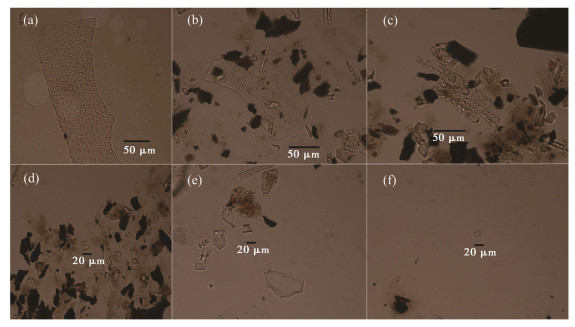
|
图 2 石城子遗址具有代表性的植硅体形态 (a~b)黍;(c)大麦(青稞);(d)哑铃型;(e)帽型;(f)短鞍型 Fig. 2 Shapes of representative phytoliths from Shichengzi site. (a~b) Panicum miliaceum(common millet); (c)Hordeum vulgare L.(naked barley); (d)Dumbbell; (e)Hat; (f)Short saddle |
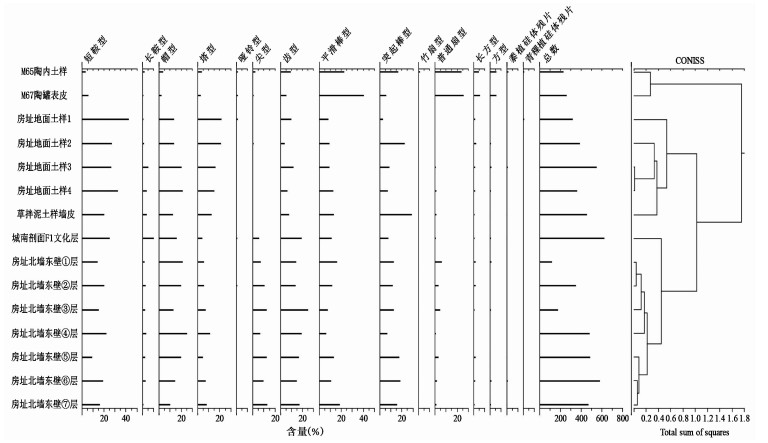
|
图 3 石城子遗址各样品植硅体组合百分比及聚类分析 Fig. 3 Percentage and cluster analysis of phytolith assemblages in Shichengzi site |
一般而言,判断骨样是否受污染,通常是根据骨胶原C、N含量以及C、N摩尔比值。正常骨胶原C、N含量应处在15.3%~47.0%和5.5%~17.3%,且C、N摩尔比值介于2.9~3.6之间[29]。石城子遗址19例动物骨样骨胶原测试结果显示其C、N含量分别处在28.9%~41.9%和10.6%~15.1%,C与N摩尔比值介于3.1与3.2之间(表 3),这很好地满足上述标准,表明石城子遗址动物骨样均保存较好。
| 表 3 石城子遗址动物骨骼样品碳氮同位素结果 Table 3 Carbon and nitrogen isotopic results for animal bone collagen from Shichengzi site |
石城子遗址出土的动物骨样包括了杂食动物狗(Canis familiaris )、家养食草动物羊(Ovis sp./Capra sp.)、牛(Bos sp.)以及野生食草动物鹿(Cervidae),其中狗骨具有较为偏负的δ13C值与偏正的δ15N值,分别为-18.4‰和10.8‰。羊骨δ13C值与δ15N值变化较为显著,其中δ13C与δ15N分别在-19.1‰ ~-17.2‰与6.4‰ ~11.2‰之间变化,剔除3个幼羊个体后,羊骨δ13C值与δ15N均值分别为-18.3±0.5‰和7.5±0.8‰ (n=10)。与羊类似,2例牛骨样品δ13C与δ15N值变化较大,均值分别为-18.9±1.4‰和8.0±1.2‰ (n=2)。野生食草动物鹿骨具有与家养动物牛相类似的δ13C与δ15N值,分别为-18.4‰和8.1‰。不可鉴定种属的2例食草动物骨样δ13C与δ15N均值分别为-19.1±2.1‰和7.4±2.7‰ (n=2)(表 3)。
4 讨论 4.1 石城子遗址农作物组成与生业策略新疆地区的农业起始于青铜时期,该时期驯化于中国北方的粟黍和源自西亚的小麦、大麦已经相向传播至新疆[30~32],两汉时期中原王朝在西域的屯田政策更是进一步推动了新疆地区农业经济的快速发展,比如《汉书·西域传》记载“自且末已往皆种五谷,土地草木、畜产、作兵略与汉同”。不过,对于两汉时期石城子遗址的农作物组成与生业类型,由于文献较少涉及,因此我们了解不多。而通过石城子遗址房址地面、墙体地层以及陶罐土壤样品的植硅体分析,我们发现遗址中存在着黍与青稞两种作物(图 2)。黍作为中国北方史前旱作农业的代表性作物,具有耐旱、耐瘠以及生长期较短等特性,已广泛出现在新疆多处早期遗址[33~35]。青稞不仅具有生长期需水少且生长期较短的优势,同时还具有较强的耐霜冻性,比较适宜在石城子遗址所处的山前丘陵地带种植,并且研究发现公元前一千纪以来石城子遗址所在的新疆东天山地区便已普遍存在种植青稞的传统[33, 36]。在石城子遗址中,黍类作物出现的频率与数量要明显高于青稞,也许表明了黍类作物在石城子遗址驻军饮食中的重要地位。在植物的选择与利用中,黍作物的重要程度高于青稞的情况在新疆天山以南同时期遗址比如营盘、洋海墓地也可见到[33, 37]。除了黍与青稞以外,两汉时期的新疆遗址比如尼雅遗址、故吐火罗城以及罗布淖尔五号墓地等[38],通常还出土粟和小麦作物,不过这些作物尚未能在石城子遗址的土壤样品中发现。另外,石城子遗址中出土的狗、羊、牛以及鹿等动物骨骼表明遗址驻军除了从事农业活动以外,同时还开展一定规模的畜牧与少量的狩猎活动。类似的情况在与石城子遗址同属于车师后国的吉木萨尔县小西沟遗址中同样可以见到,该遗址出土了众多的马(Equus sp.)、羊(Ovis sp./Capra sp.)以及骆驼(Camelus)等动物骨骼样品[39]。而多个遗址的动物遗存证据进一步表明畜牧业是石城子遗址所在的天山北麓地区汉代人群重要的生业组成。不过,不同动物种属在石城子遗址中的作用可能有所差别,其中家养动物狗,可能更多参与到警卫、放牧与狩猎等活动[40]。家养食草动物羊,在石城子遗址中发现数量最多,应该在肉、奶以及皮毛等初级、次级资源的提供上发挥着重要作用[41~42];同属家养食草动物的牛,除了提供肉或奶以外,可能还起到提供重要劳力的作用比如驮运、农田开垦等[43];野生食草动物鹿则可能主要作为肉食食用。黍作和麦作农业、以羊牛为主的畜牧业与狩猎活动一道构成了石城子遗址汉代驻军多样的生业组成,并为遗址驻军提供了丰富的粮食作物和肉食资源。
4.2 石城子遗址植物资源的加工与处理遗址土壤样品的植硅体分析不仅有助于了解石城子遗址汉代驻军的农作物组成,而且对于揭示遗址内对于植物资源的加工、处理等活动具有重要帮助。禾本科植硅体由于光合作用途径的差异可分为C3植物与C4植物,其中C3植物以早熟禾亚科(Pooideae)植硅体为代表,主要包括了帽型、齿型等短细胞植硅体;C4植物则以画眉草亚科(Eragrostoideae)和黍亚科(Panicoideae)植硅体为代表,主要包括了短鞍型和哑铃型等短细胞植硅体[44]。而由于C4型与C3型植硅体的生存环境存在明显差异,其中C4型植硅体适宜生长在温暖湿润的环境,而C3型植硅体则主要分布在干旱或寒冷的环境,因此C4型植硅体与C3型植硅体的含量比值常被用于探讨遗址周围的环境变化[45~48]。不过在本文中,考虑到遗址是人类活动的产物,那么遗址中特别是房址内土样植硅体C4、C3含量比重是否可以指示人类文化活动特别是人类对植物资源的利用与处理?为了验证这一猜测,我们选择来自石城子遗址房址地面土样、房址墙体地层土样与表征自然环境的新疆表土,对这3种不同土样中的C4、C3型植硅体比值进行分析。新疆地区现代表土因土样类型的不同,C4、C3植硅体所占比例存在一些差异,不过均表现为C4型植硅体比重小于C3型植硅体[49~50],而进一步分析石城子遗址房址地面土样与房址墙体地层土样的植硅体数据,我们发现房址墙体地层土样植硅体C4/C3比值介于0.4与0.8之间,与新疆现代表土植硅体C4/C3比值基本一致,而房址地面土样植硅体C4/C3比值介于0.8与1.9之间,则显著高于新疆现代表土植硅体C4/C3比值范围(图 4)。虽然房址地面土样取自于房内坍塌土堆积,但其如此高比例的C4型植硅体(或植硅体C4/C3比值)比重且与房址墙体土样的植硅体C4/C3比值之间存在显著差别,说明房址地面土样中应该还包含一定的房址坍塌前的地面土样沉积,进一步分析推断房址中也许存在着石城子遗址驻军对植物资源的选择与利用活动。由于画眉草亚科和黍亚科等C4型植硅体多生长在温暖环境[49],一般情况下在石城子遗址所在的山前丘陵地带很难出现如此高比例的C4型植硅体,据此分析该C4型植硅体可能不是来自于遗址周围的自然植被。而考虑到石城子遗址可能存在一定规模的黍作农业,画眉草亚科一类的C4植物作为混生于黍作田地的杂草,则很有可能在石城子遗址驻军收割黍类作物的同时也被一同收割,并且通过脱壳处理将稃皮、茎叶废弃或作为燃料集中堆放,故而促使房址内C4型植硅体比重的提高。当然,该分析还需后期对遗址出土的石臼与石磨盘等与粮食加工相关的工具开展残留物分析来加以论证。而相较于房址内土样,石城子遗址地层样品中的C4型植硅体比重(或C4型与C3型植硅体比值)明显较低,与自然环境比较接近,表明受到人类活动影响相对较小,也许可以用于指示遗址的微环境状况,未来将结合年代学与孢粉研究对其进一步研究。
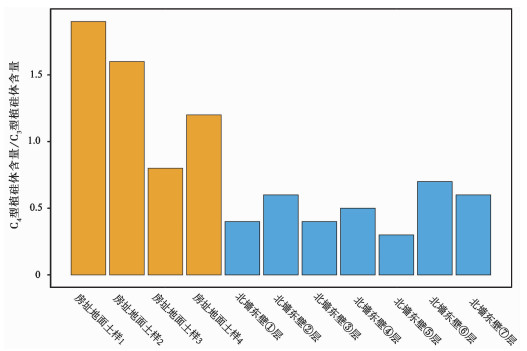
|
图 4 4石城子遗址不同取样单位土样C4型植硅体与C3型植硅体含量比值对比 Fig. 4 Comparison of ratios of C4 and C3 phytoliths content from different sampling units in Shichengzi site |
在古城遗址的建造过程中,人们通常会选择使用草拌泥涂抹墙面以增加房址墙体的坚固性和防潮性[51~53]。我们在石城子遗址同样也采集了草拌泥土壤样品,并且通过对其进行植硅体鉴定与分析,在其中发现了黍稃壳,推断在草拌泥中添加黍碎壳可能是为了在遗址墙体建造中起到更好的粘合剂作用。而这种利用农作物副产品进行建造的行为不仅出现在石城子遗址,在新疆以及中亚地区其他遗址或墓地同样有类似的发现,比如在哈萨克斯坦地区的Tasbas遗址[54]、新疆地区的楼兰古城[55]与艾斯克霞尔南墓地[56]中均可以见到将麦秸、小米秸秆或碎壳作为墙体或泥砖建筑粘合剂的证据,而且这种建筑传统在新疆现代农村的民居建筑中同样也比较常见[57]。
4.3.2 石城子遗址家畜饲养与谷物栽培借助于稳定同位素技术,我们可以了解石城子遗址古人的家畜饲养策略特别是家畜饲养与农业之间的可能关系(图 5)。石城子遗址鹿骨碳同位素数值低于-18‰,表明其主要摄食C3植物,这与新疆天山地区以C3植物为主,C4植物的比重相对较低的植被组成是比较一致的[58],因此,野生食草动物鹿骨的稳定同位素数据基本反映了遗址周围自然环境条件下的摄食状况,这为解读石城子遗址内家畜的饮食组成提供了重要基准。石城子遗址杂食动物狗的碳同位素数值与鹿比较类似(图 5),表明同样是以C3食物为主。不过,由于C3作物青稞与C3类野生植物的碳同位素分布区间是相互重叠的,因此,我们很难通过同位素证据准确评估C3作物青稞对狗饮食的贡献,以后可能还需其他技术手段加以研究。而从狗骨较高的氮同位素数值以及其与羊之间氮同位素差值比较符合相邻营养级3‰ ~5‰差值范围分析[59],古人食用剩下的羊骨可能是石城子遗址杂食动物狗C3饮食的重要来源。石城子遗址中大部分羊牛等家养食草动物的碳同位素数值与鹿也是比较一致,表明石城子遗址羊、牛群可能主要是通过放牧摄食遗址周围C3类野草,不过也无法完全排除羊牛等家畜有机会接触并摄食C3作物青稞秸秆的可能。在汉晋时期的精绝国,便存在着将青稞秸秆作为家畜饲料利用的证据[60]。而相较于鹿,石城子遗址存在部分羊包括幼羊以及牛具有较为偏正的碳氮同位素数值。对于幼羊而言,哺乳效应可能是导致其碳氮同位素数值提高的重要原因[61~62],而对于其他成年羊牛个体较高的碳氮同位素数值,分析可能是由于羊牛在干旱盐碱环境下摄食少量C4草本植物的结果[63]。另外,考虑到石城子遗址中可能存在一定规模的C4黍作农业,因此需要思考黍作农业对食草动物同位素数值的可能影响。在青铜时期的中原与甘肃河西走廊地区便已普遍发现古人利用C4作物粟黍副产品对食草动物羊、牛进行饲喂的案例[64~69],而在新疆地区,通过对比分析已发表的同一遗址出土人骨与羊骨的碳同位素数据[70~79],我们同样可以发现粟黍农业对新疆古人及羊群C4饮食的一致影响(图 6a),即当古人接触并摄食大量的C4作物粟黍时,羊群C4饮食的比例也会相应增加(Ⅰ组),反之亦然(Ⅱ组)。由于石城子遗址尚未开展相关的人骨同位素研究,无法与之进行对比,不过我们仍然可以将石城子遗址羊骨同位素数据与新疆不同农业背景下的羊骨数据进行对比,以对石城子遗址羊群C4饮食来源作进一步了解。对比发现石城子遗址羊骨数据所在贝叶斯标准椭圆区域与这两组区域均有所重叠(图 6b),其中与无显著粟黍农业证据组的重叠区域大概为55 % (图 6c),而与存在显著粟黍农业证据组的重叠区域高达75 % (图 6d)。该分析表明石城子遗址中驻军除了通过放牧使羊群觅食C3野草以外,还可能通过饲喂黍作物秸秆的方式对其饮食进行补充。该推论与天山南麓吐鲁番盆地胜金店遗址植物考古研究发现的马内脏中存在未消化的黍粒茅草,认为黍类作物构成了动物比如马的饲料来源的结论是基本一致的[80],同时本文的推论在一定程度上也得到了新疆东天山地区现代民族学调查发现的在牧草短缺时期人们选择用谷壳秸秆来饲养羊等家畜的证实[81]。
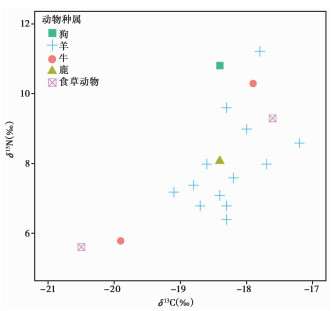
|
图 5 5石城子遗址动物骨骼碳氮同位素分布 Fig. 5 Carbon and nitrogen isotopic values of animal bones from Shichengzi site |
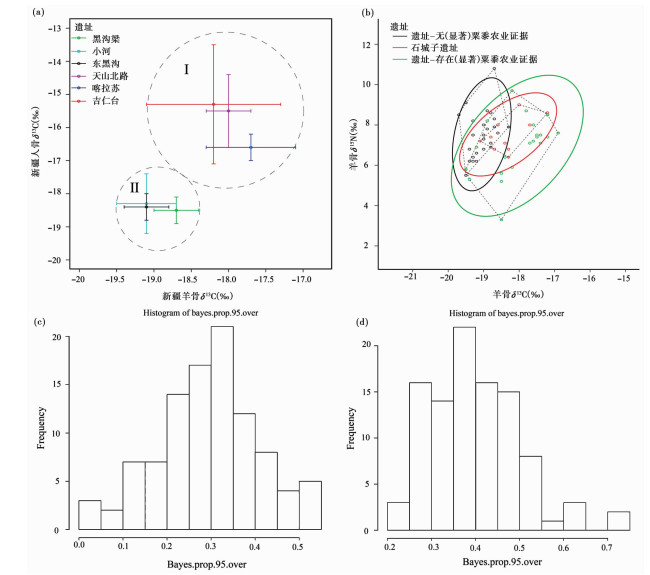
|
图 6 (a) 新疆已发表的同一遗址人骨-羊骨碳同位素数据对比[70~79];(b)石城子遗址羊骨碳氮同位素数据与新疆不同农业背景下的羊骨同位素数据的对比;(c)石城子遗址与新疆无(显著)粟黍农业证据遗址之间羊骨同位素椭圆分布的重叠百分比;(d)石城子遗址与新疆存在(显著)粟黍农业证据遗址之间羊骨同位素椭圆分布的重叠百分比 Fig. 6 (a)Comparison of carbon isotopic data of paired human and sheep bone from the same site in Xinjiang[70~79]; (b)Comparison of carbon and nitrogen isotopic data of sheep bones between Shichengzi site and Xinjiang sites from different agricultural backgrounds; (c)The percentage overlap of isotopic elliptical distribution of sheep bones between Shichengzi site and Xinjiang sites without(notable)millet agriculture evidence; (d)The percentage overlap of isotopic elliptical distribution of sheep bones between Shichengzi site and Xinjiang sites with(notable)millet agriculture evidence |
通过对新疆石城子遗址土壤样品的植硅体分析与动物骨骼样品的稳定碳氮同位素分析,我们对两汉时期石城子遗址驻军的农作物利用策略及其生业组成进行了探讨。研究发现:
(1) 黍与青稞构成了石城子遗址驻军重要的粮食来源,遗址里不同取样单位的C4/C3植硅体分析揭示了驻军可能在房址从事植物资源的加工与处理活动,也许是对谷物进行脱壳。
(2) 石城子遗址草拌泥墙皮土样的植硅体分析表明黍秸秆或碎壳等农业副产品可能在石城子遗址墙体的建设中发挥着重要的粘合剂作用。
(3) 动物骨骼稳定同位素研究揭示了黍类作物或者可能的青稞秸秆等农业副产品可能对遗址中羊、牛等家养食草动物的C4饮食起到一定贡献。
(4) 以黍与青稞为主的农业,以羊、牛为主的畜牧业以及一定的狩猎活动构成了石城子遗址驻军多样的生业策略。
致谢: 感谢审稿专家和编辑部赵淑君老师建设性的修改意见!
| [1] |
田小红, 吴勇, 多斯江, 等. 新疆奇台石城子遗址2016年发掘简报[J]. 文物, 2018(5): 4-25. Tian Xiaohong, Wu Yong, Duo Sijiang, et al. The 2016 excavation of the Shichengzi site in Qitai County, Xinjiang[J]. Cultural Relics, 2018(5): 4-25. |
| [2] |
高荣. 汉代戊己校尉述论[J]. 西域研究, 2000(2): 1-6. Gao Rong. The review of Wujixiaowei from Han Dynasty[J]. The Western Regions Studies, 2000(2): 1-6. |
| [3] |
司马彪, 刘昭, 刘华祝. 后汉书[M]. 长春: 吉林人民出版社, 1995: 21. Sima Biao, Liu Zhao, Liu Huazhu. Book of Post-Han Dynasty[M]. Changchun: Jilin People's Press, 1995: 21. |
| [4] |
樊根耀. 论古代新疆屯垦的经济意义[J]. 西北民族大学学报(哲学社会科学版), 2006(4): 19-23. Fan Genyao. On economic meaning of stationing troops to open up wasteland in Xinjiang[J]. Journal of Northwest University for Nationalities(Philosophy and Social Science), 2006(4): 19-23. |
| [5] |
张运德. 两汉时期西域屯垦的基本特征[J]. 西域研究, 2007(3): 6-12. Zhang Yunde. The basic characteristics of stationing troops to open up wasteland in the Western Regions in the Han Dynasty[J]. The Western Regions Studies, 2007(3): 6-12. |
| [6] |
龙娟.我国西北边疆军屯制度研究[D].长沙: 湖南师范大学硕士学位论文, 2010: 1-49. Long Juan. Research on the Military Cultivation System in the Northwestern Frontier of China[D]. Changsha: The Master's Thesis of Hunan Normal University, 2010: 1-49. http://cdmd.cnki.com.cn/Article/CDMD-10542-2010127016.htm |
| [7] |
王永吉, 吕厚远. 植物硅酸体研究及应用[M]. 北京: 海洋出版社, 1993: 228. Wang Yongji, Lü Houyuan. The Study of Phytolith and Its Application[M]. Beijing: China Ocean Press, 1993: 228. |
| [8] |
Piperno D R. Phytoliths:A Comprehensive Guide for Archaeologists and Paleoecologists[M]. Lanham, New York, Toronto, Oxford: Alta Mira Press, 2006: 238.
|
| [9] |
Rovner I. Macro and micro-ecological reconstruction using plant opal phytolith data from archaeological sediments[J]. Geoarchaeology, 1988, 3(2): 155-163. |
| [10] |
靳桂云, 方燕明, 王春燕. 河南登封王城岗遗址土壤样品的植硅体分析[J]. 中原文物, 2007(2): 93-100. Jin Guiyun, Fang Yanming, Wang Chunyan. The phytolith research in soil samples of Wangchenggang site, Dengfeng, Henan Province[J]. Cultural Relics of Central China, 2007(2): 93-100. |
| [11] |
王灿, 吕厚远, 张健平, 等. 青海喇家遗址齐家文化时期粟作农业的植硅体证据[J]. 第四纪研究, 2015, 35(1): 1-9. Wang Can, Lü Houyuan, Zhang Jianping, et al. Phytolith evidence of millet agriculture in the late Neolithic archaeological site of Lajia, Northwestern China[J]. Quaternary Sciences, 2015, 35(1): 1-9. |
| [12] |
Zhang J, Lu H, Jia P W, et al. Cultivation strategies at the ancient Luanzagangzi settlement on the easternmost Eurasian steppe during the late Bronze Age[J]. Vegetation History and Archaeobotany, 2017, 26(5): 505-512. |
| [13] |
邵孔兰, 张健平, 丛德新, 等. 植物微体化石分析揭示阿敦乔鲁遗址古人生存策略[J]. 第四纪研究, 2019, 39(1): 37-47. Shao Konglan, Zhang Jianping, Cong Dexin, et al. Analysis of plant microfossils reveals the ancient survival strategy of the Adunqiaolu site in Xinjiang, China[J]. Quaternary Sciences, 2019, 39(1): 37-47. |
| [14] |
戴锦奇, 左昕昕, 蔡喜鹏, 等. 闽江下游白头山遗址稻旱混作农业的植硅体证据[J]. 第四纪研究, 2019, 39(1): 161-169. Dai Jinqi, Zuo Xinxin, Cai Xipeng, et al. The mixed rice and millet agriculture in Neolithic age lower Minjiang River:Phytolith evidence from the Baitoushan site[J]. Quaternary Sciences, 2019, 39(1): 161-169. |
| [15] |
王灿, 吕厚远, 顾万发, 等. 全新世中期郑州地区古代农业的时空演变及其影响因素[J]. 第四纪研究, 2019, 39(1): 108-122. Wang Can, Lü Houyuan, Gu Wanfa, et al. Spatial-temporal evolution of agriculture and factors influencing it during the mid-Holocene in Zhengzhou area, China[J]. Quaternary Sciences, 2019, 39(1): 108-122. |
| [16] |
胡耀武, 胡松梅, 孙周勇, 等. 陕北靖边五庄果墚动物骨的C和N稳定同位素分析[J]. 第四纪研究, 2008, 28(6): 1160-1165. Hu Yaowu, Hu Songmei, Sun Zhouyong, et al. Stable isotopic analysis on animal bones from the Wuzhuangguoliang site, Jingbian, Northern Shaanxi[J]. Quaternary Sciences, 2008, 28(6): 1160-1165. |
| [17] |
侯亮亮, 徐海峰. 河北赞皇南马遗址先商文化时期动物骨骼的稳定同位素分析[J]. 边疆考古研究, 2015(1): 385-397. Hou Liangliang, Xu Haifeng. Stable isotopic analysis of animal bones at Nanma site, Zanhuang, Hebei, China during the Proto-Shang culture[J]. Research of China's Frontier Archaeology, 2015(1): 385-397. |
| [18] |
Dai L L, Li Z P, Zhao C Q, et al. An isotopic perspective on animal husbandry at the Xinzhai site during the initial stage of the legendary Xia Dynasty(2070-1600 BC)[J]. International Journal of Osteoarchaeology, 2016, 26(5): 885-896. |
| [19] |
Dong W, An C B, Fan W, et al. Stable isotopic detection of manual intervention among the faunal assemblage from a Majiayao site in NW China[J]. Radiocarbon, 2016, 58(2): 311-321. |
| [20] |
Ren L, Li X, Kang L, et al. Human paleodiet and animal utilization strategies during the Bronze Age in northwest Yunnan Province, Southwest China[J]. PLoS One, 2017, 12(5): e0177867. |
| [21] |
Zhou L, Hou Y, Wang J, et al. Animal husbandry strategies in Eastern Zhou China:An isotopic study on faunal remains from the Central Plains[J]. International Journal of Osteoarchaeology, 2018, 28(3): 354-363. |
| [22] |
屈亚婷, 易冰, 胡珂, 等. 我国古食谱稳定同位素分析的影响因素及其蕴含的考古学信息[J]. 第四纪研究, 2019, 39(6): 1487-1502. Qu Yating, Yi Bing, Hu Ke, et al. Factors influencing isotopic paleodiet analyses and the archaeological researches in China[J]. Quaternary Sciences, 2019, 39(6): 1487-1502. |
| [23] |
中国社会科学院考古研究所. 中国考古学中碳十四年代数据集, 1965-1991[M]. 北京: 文物出版社, 1992: 321. Chinese Academy of Social Sciences Institute of Archaeology. Radiocarbon Dates in Chinese Archaeology, 1965-1991[M]. Beijing: Cultural Relics Publishing House, 1992: 321. |
| [24] |
杨婷婷, 李晓洁. 新疆江布拉克旅游业发展对农牧民增收贡献研究[J]. 天津农业科学, 2018, 24(1): 15-17. Yang Tingting, Li Xiaojie. Study on Jiang Braque tourism industry development's contribution to farmers and herdsmen's in come increasing of Xinjiang[J]. Tianjin Agricultural Sciences, 2018, 24(1): 15-17. |
| [25] |
新疆文物考古研究所. 2017年度奇台县石城子遗址考古发掘报告[J]. 新疆文物, 2018(1-2): 4-20. Xinjiang Institute of Archaeology. The 2017 excavation of the Shichengzi site in Qitai County, Xinjiang[J]. Cultural Relics of Xinjiang, 2018(1-2): 4-20. |
| [26] |
Lu H, Zhang J, Wu N, et al. Phytoliths analysis for the discrimination of foxtail millet(Setaria italica) and common millet (Panicum miliaceum)[J]. PLoS One, 2009, 4(2): e4448. |
| [27] |
Rosen A M. Preliminary identification of Silica Skeletons from Near Eastern Archaeological Sites:An Anatomical Approach[M]. Boston M A: Springer, 1992: 129-147.
|
| [28] |
Grimm E C. CONISS:A FORTRAN 77 program for stratigraphically constrained cluster analysis by the method of incremental sum of squares[J]. Computers & Geosciences, 1987, 13(1): 13-35. |
| [29] |
DeNiro M J. Postmortem preservation and alteration of in vivo bone collagen isotope ratios in relation to palaeodietary reconstruction[J]. Nature, 1985, 317(6040): 806. |
| [30] |
安成邦, 王伟, 段阜涛, 等. 亚洲中部干旱区丝绸之路沿线环境演化与东西方文化交流[J]. 地理学报, 2017, 72(5): 875-891. An Chengbang, Wang Wei, Duan Futao, et al. Environmental changes and cultural exchange between East and West along the Silk Road in arid Central Asia[J]. Acta Geographica Sinica, 2017, 72(5): 875-891. |
| [31] |
安成邦, 王伟, 刘依, 等. 新疆全新世环境变迁与史前文化交流[J]. 中国科学:地球科学, 2019, 49. An Chengbang, Wang Wei, Liu Yi, et al. The Holocene environmental change in Xinjiang and its impact on prehistoric cultural exchange[J]. Science China:Earth Sciences, 2019, 49: 49. |
| [32] |
安成邦, 张曼, 王伟, 等. 新疆地理环境特征以及农牧格局的形成[J]. 中国科学:地球科学, 2020, 50(2): 295-304. An Chengbang, Zhang Man, Wang Wei, et al. The pattern of Xinjiang physical geography and its relationship with the temporal-spatial distribution of agriculture and husbandry[J]. Science China:Earth Sciences, 2020, 50(2): 295-304. |
| [33] |
蒋洪恩, 李肖, 李承森. 新疆吐鲁番洋海墓地出土的粮食作物及其古环境意义[J]. 古地理学报, 2007, 9(5): 551-558. Jiang Hongen, Li Xiao, Li Chengsen. Cereal remains from Yanghai Tomb in Turpan, Xinjiang and their palaeoenvironmental significance[J]. Journal of Palaeogeography, 2007, 9(5): 551-558. |
| [34] |
赵克良, 李小强, 周新郢, 等. 新疆新塔拉遗址农业活动特征及其影响的植物指标记录[J]. 第四纪研究, 2012, 32(2): 219-225. Zhao Keliang, Li Xiaoqiang, Zhou Xinying, et al. Characteristics of agricultural activities and its impact on the environment at Xintala site, Xinjiang, reconstructed from archaeological plant remains[J]. Quaternary Sciences, 2012, 32(2): 219-225. |
| [35] |
Yang R, Yang Y, Li W, et al. Investigation of cereal remains at the Xiaohe Cemetery in Xinjiang, China[J]. Journal of Archaeological Science, 2014, 49: 42-47. |
| [36] |
Tian D, Ma J, Wang J X, et al. Cultivation of naked barley by early Iron Age agro-pastoralists in Xinjiang, China[J]. Environmental Archaeology, 2018, 23(4): 416-25. |
| [37] |
Chen T, Wang X, Dai J, et al. Plant use in the Lop Nor region of southern Xinjiang, China:Archaeobotanical studies of the Yingpan cemetery(~25-420 AD)[J]. Quaternary international, 2016, 426: 166-74. |
| [38] |
卫斯. 西域农业考古资料索引[J]. 农业考古, 2004(3): 282-299. Wei Si. Idexing of agricultural archaeology data in the western regions[J]. Agricultural Archaeology, 2004(3): 282-299. |
| [39] |
闫顺, 闫耀平. 吉木萨尔县地区历史时期环境演变与人类活动[J]. 干旱区地理学集刊, 1993(3): 162-175. Yan Shun, Yan Yaoping. Human activities and environmental change in Jimusaer region during the historical periods[J]. Geographical Symposium of Arid Zone, 1993(3): 162-175. |
| [40] |
余孚. 古代"六畜"之一——狗[J]. 古今农业, 1995(2): 70-77. Yu Fu. One of the ancient six livestock-Dog[J]. Ancient and Modern Agriculture in China, 1995(2): 70-77. |
| [41] |
尤悦, 钟华, 余罛. 新疆巴里坤县石人子沟遗址生业考古的民族学调查与研究[J]. 南方文物, 2016(2): 116-122. You Yue, Zhong Hua, Yu Chong. The ethnological surveys and study of subsistence in Shirenzigou site, Balikun County, Xinjiang[J]. Cultural Relics in Southern China, 2016(2): 116-122. |
| [42] |
左豪瑞. 中国家羊的动物考古学研究综述和展望[J]. 南方文物, 2017(1): 155-163. Zuo Haorui. The review and prospect of zooarchaeological research on Chinese demestic sheep/goat[J]. Cultural Relics in Southern China, 2017(1): 155-163. |
| [43] |
张振新. 汉代的牛耕[J]. 文物, 1977(8): 57-62. Zhang Zhenxin. Cattle farming in the Han Dynasty[J]. Cultural Relics, 1977(8): 57-62. |
| [44] |
Twiss P C. Predicted world distribution of C3 and C4 grass phytolith[M]//Rapp J G, Mulholland S C. Phytolith Systematics: Emerging Issues, Advances in Archaeological and Museum Science. New York: Plenum Press, 1992: 113-128.
|
| [45] |
姜钦华, 宋豫秦, 李亚东. 河南驻马店市杨庄龙山文化遗址的植硅石分析[J]. 考古, 1996(4): 87-90. Jiang Qinhua, Song Yuqin, Li Yadong. Phytolith analysis of Yangzhuang Longshan cultural relics in Zhumadian City, Henan Province[J]. Archaeology, 1996(4): 87-90. |
| [46] |
姚政权, 吴妍, 王昌燧, 等. 河南新密市新砦遗址的植硅石分析[J]. 考古, 2007(3): 90-96. Yao Zhengquan, Wu Yan, Wang Changsui, et al. A phytolith analysis from the Xinzhai site in Xinmi City, Henan[J]. Archaeology, 2007(3): 90-96. |
| [47] |
夏秀敏, 孙周勇, 杨利平, 等. 陕北榆林王阳畔遗址的植硅体分析[J]. 人类学学报, 2016, 35(2): 257-266. Xia Xiumin, Sun Zhouyong, Yang Liping, et al. Phytolith analysis from archaeological site of Wangyangpan, Yulin, North Shaanxi[J]. Acta Anthropologica Sinica, 2016, 35(2): 257-266. |
| [48] |
韩佳宜. 孢粉与植硅体的史前自然环境指示意义——以两处史前遗址为例[J]. 文物世界, 2017(3): 14-16. Han Jiayi. Prehistoric natural environment indications of pollen and phytolith:Taking two prehistoric sites as examples[J]. World of Antiquity, 2017(3): 14-16. |
| [49] |
吕厚远, 王永吉. 晚更新世以来洛川黑木沟黄土地层中植物硅酸体研究及古植被演替[J]. 第四纪研究, 1991(1): 72-84. Lü Houyuan, Wang Yongji. A study on phytoliths in loess profile and paleoenvironmental evolution at Heimugou in Luochuan, Shannxi Province since Late Pleistocene[J]. Quaternary Sciences, 1991(1): 72-84. |
| [50] |
吴乃琴, 吕厚远, 聂高众, 等. C3、C4植物及其硅酸体研究的古生态意义[J]. 第四纪研究, 1992(3): 241-251. Wu Naiqin, Lü Houyuan, Nie Gaozhong, et al. The study of phytoliths in C3 and C4 grasses and its paleoecological significance[J]. Quaternary Sciences, 1992(3): 241-251. |
| [51] |
翟霖林. 试析仰韶文化中期的五边形房址[J]. 华夏考古, 2013(1): 28-33. Zhai Linlin. Analysis of the pentagon house in the middle Yangshao Culture[J]. Huaxia Archaeology, 2013(1): 28-33. |
| [52] |
顾万发, 吴倩, 张贺君, 等. 河南新郑望京楼遗址商代小型房址发掘简报[J]. 中国国家博物馆馆刊, 2015(1): 3. Gu Wanfa, Wu Qian, Zhang Hejun, et al. Excavation of small-scale Shang Dynasty housing sites in the Wangjinglou site in Xinzheng City, Henan Province[J]. Journal of National Museum of China, 2015(1): 3. |
| [53] |
孙周勇, 邵晶. 论寨峁梁房址的建造、使用和废弃[J]. 考古与文物, 2018(1): 72-78. Sun Zhouyong, Shao Jing. The construction, use and disposal of the Zhaimaoliang housing site[J]. Archaeology and Cultural Relics, 2018(1): 72-78. |
| [54] |
Doumani P N, Frachetti M D, Beardmore R, et al. Burial ritual, agriculture, and craft production among Bronze Age pastoralists at Tasbas(Kazakhstan)[J]. Archaeological Research in Asia, 2015(1): 17-32. |
| [55] |
侯灿. 楼兰出土糜子、大麦及珍贵的小麦花[J]. 农业考古, 1985(2): 225-227. Hou Can. The broomcorn millet, barley and valuable wheat flower from the Loulan site[J]. Agricultural Archaeology, 1985(2): 225-227. |
| [56] |
Zhang G, Wang Y, Spate M, et al. Investigation of the diverse plant uses at the South Aisikexiaer Cemetery(~2700-2400 years BP) in the Hami Basin of Xinjiang, Northwest China[J]. Archaeological and Anthropological Sciences, 2019, 11(2): 699-711. |
| [57] |
孟福利, 岳邦瑞, 王军. 乡土材料在传统聚落营造中的生态智慧及启示——以鄯善县麻扎村为例[J]. 华中建筑, 2011, 29(1): 166-168. Meng Fuli, Yue Bangrui, Wang Jun. The local materials in traditional settlement-construction of ecology wisdom and enlightenment:A case study of Mazha Village in Shanshan County[J]. Huazhong Architecture, 2011, 29(1): 166-168. |
| [58] |
张慧文.天山现代植物和表土有机稳定碳同位素组成的海拔响应特征[D].兰州: 兰州大学博士学位论文, 2010: 61. Zhang Huiwen. Variation in Organic Carbon Isotope Composition Values of Plant and Surface Soil along An Altitude Gradient in the Tianshan Mountains[D]. Lanzhou: The Doctoral Dissertation of Lanzhou University, 2010: 61. http://cdmd.cnki.com.cn/Article/CDMD-10730-1011034249.htm |
| [59] |
Bocherens H, Drucker D. Trophic level isotopic enrichment of carbon and nitrogen in bone collagen:Case studies from recent and ancient terrestrial ecosystems[J]. International Journal of Osteoarchaeology, 2003, 13(1-2): 46-53. |
| [60] |
卫斯.尼雅遗址农业考古揭秘——精绝国农业考古资料搜括记述[Z].中国历史文化遗产保护网.www.wenbao.net Wei Si. The Agricultural Archaeology at the Niya Site-The description of the Jinjue state agricultural archaeological materials[Z]. www.wenbao.net |
| [61] |
Mays S A, Richards M P, Fuller B T. Bone stable isotope evidence for infant feeding in Mediaeval England[J]. Antiquity, 2002, 76(293): 654-656. |
| [62] |
Fuller B T, Fuller J L, Harris D A, et al. Detection of breastfeeding and weaning in modern human infants with carbon and nitrogen stable isotope ratios[J]. American Journal of Physical Anthropology, 2006, 129(2): 279-293. |
| [63] |
Britton K, Müldner G, Bell M. Stable isotope evidence for salt-marsh grazing in the Bronze Age Severn Estuary, UK:Implications for palaeodietary analysis at coastal sites[J]. Journal of Archaeological Science, 2008, 35(8): 2111-2118. |
| [64] |
Atahan P, Dodson J, Li X, et al. Subsistence and the isotopic signature of herding in the Bronze Age Hexi Corridor, NW Gansu, China[J]. Journal of Archaeological Science, 2011, 38(7): 1747-1753. |
| [65] |
侯亮亮, 李素婷, 胡耀武, 等. 先商文化时期家畜饲养方式初探[J]. 华夏考古, 2013(2): 130-138. Hou Liangliang, Li Suting, Hu Yaowu, et al. The livestock feeding strategies adopted by proto-Shang societies[J]. Huaxia Archaeology, 2013(2): 130-138. |
| [66] |
张雪莲, 赵春青. 新砦遗址出土部分动物骨的碳氮稳定同位素分析[J]. 南方文物, 2015(4): 232-240. Zhang Xuelian, Zhao Chunqing. Stable carbon and nitrogen isotopic analysis of animal bones in Xinzhai Site[J]. Cultural Relics in Southern China, 2015(4): 232-240. |
| [67] |
Chen X L, Hu S M, Hu Y W, et al. Raising practices of Neolithic livestock evidenced by stable isotope analysis in the Wei River valley, North China[J]. International Journal of Osteoarchaeology, 2016, 26(1): 42-52. |
| [68] |
陈相龙, 方燕明, 胡耀武, 等. 稳定同位素分析对史前生业经济复杂化的启示:以河南禹州瓦店遗址为例[J]. 华夏考古, 2017(4): 79-84. Chen Xianglong, Fang Yanming, Hu Yaowu, et al. Enlightenment from the stable carbon and nitrogen isotope analysis of complication of subsisting economy:A case study in Wadian site, Henan[J]. Huaxia Archaeology, 2017(4): 70-79. |
| [69] |
Yang Y, Ren L, Dong G, et al. Economic change in the Prehistoric Hexi Corridor (4800-2200 BP), North-West China[J]. Archaeometry, 2019, 61(4): 957-976. |
| [70] |
Eng J T, Zhang Q, Zhu H. Stable Isotope Analysis of Diet among Bronze Age and Iron Age Inhabitants of Xinjiang Uyghur Autonomous Region, China[Z]. Poster presented at the 78th Annual Meeting of the American Association of Physical Anthropologists, Chicago, Illinois, 2009. http://homepages.wmich.edu/~jzy8882/docs/Eng_AAPA_2009_Isotope_poster.pdf
|
| [71] |
张全超, 常喜恩, 刘国瑞. 新疆巴里坤县黑沟梁墓地出土人骨的食性分析[J]. 西域研究, 2009(3): 328-333. Zhang Quanchao, Chang Xi'en, Liu Guorui. Stable isotopic analysis on human bones from Heigouliang cemetery in Barkol, Xinjiang[J]. The Western Regions Studies, 2009(3): 328-333. |
| [72] |
张全超, 常喜恩, 刘国端. 新疆哈密天山北路墓地出土人骨的稳定同位素分析[J]. 西域研究, 2010(2): 38-43. Zhang Quanchao, Chang Xi'en, Liu Guorui. Stable isotopic analysis of human bones unearthed from Tianshan Beilu cemetery in Hami, Xinjiang[J]. The Western Regions Studies, 2010(2): 38-43. |
| [73] |
凌雪, 陈曦, 王建新, 等. 新疆巴里坤东黑沟遗址出土人骨的碳氮同位素分析[J]. 人类学学报, 2013, 32(2): 219-225. Ling Xue, Chen Xi, Wang Jianxin, et al. Carbon and nitrogen isotopic analysis of human bones excavated from the Dongheigou site, Ba Likun County, Xinjiang Autonomous Region[J]. Acta Anthropological Sinica, 2013, 32(2): 219-225. |
| [74] |
凌雪, 兰栋, 陈曦, 等. 新疆巴里坤东黑沟遗址出土动物骨骼的碳氮同位素分析[J]. 西部考古, 2016, 11(2): 23. Ling Xue, Lan Dong, Chen Xi, et al. Carbon and nitrogen isotopic analysis of animal bones excavated from the Dongheigou site in Barkol County, Xinjiang Autonomous Region[J]. Western Archaeology, 2016, 11(2): 23. |
| [75] |
陈相龙, 于建军, 尤悦. 碳、氮稳定同位素所见新疆喀拉苏墓地的葬马习俗[J]. 西域研究, 2017(4): 89-98. Chen XiangLong, Yu Jianjun, You Yue. Horse burial customs in Kalasu Cemetery of Xinjiang seen from stable carbon and nitrogen isotope[J]. The Western Regions Studies, 2017(4): 89-98. |
| [76] |
Wang T T, Fuller B T, Wei D, et al. Investigating dietary patterns with stable isotope ratios of collagen and starch grain analysis of dental calculus at the Iron Age cemetery site of Heigouliang, Xinjiang, China[J]. International Journal of Osteoarchaeology, 2016, 26(4): 693-704. |
| [77] |
Wang T, Wei D, Chang X, et al. Tianshanbeilu and the isotopic millet road:Reviewing the late Neolithic/Bronze Age radiation of human millet consumption from north China to Europe[J]. National Science Review, 2017, 6(5): 1024-1039. |
| [78] |
Qu Y, Hu Y, Rao H, et al. Diverse lifestyles and populations in the Xiaohe culture of the Lop Nur region, Xinjiang, China[J]. Archaeological and Anthropological Sciences, 2018, 10(8): 2005-2014. |
| [79] |
Wang W, Wang Y, An C, et al. Human diet and subsistence strategies from the Late Bronze Age to historic times at Goukou, Xinjiang, NW China[J]. The Holocene, 2018, 28(4): 640-650. |
| [80] |
Jiang H, Zhang Y, Lü E, et al. Archaeobotanical evidence of plant utilization in the ancient Turpan of Xinjiang, China:A case study at the Shengjindian cemetery[J]. Vegetation History and Archaeobotany, 2015, 24(1): 165-177. |
| [81] |
田多.公元前一千纪东天山地区的植物考古学研究[D].西安: 西北大学博士论文, 2018: 165-167. Tian Duo. Archaeobotanical Study on the Region of East Tianshan Mountains in First Millennium BC[D]. Xi'an: The Doctoral Dissertation of Northwest University, 2018: 165-167. http://cdmd.cnki.com.cn/Article/CDMD-10697-1018106689.htm |
2 Cultural Relics and Archaeology Institute of Xinjiang Uygur Autonomous Region, Vrumchi 830011, Xinjiang;
3 School of History and Culture, Lanzhou University, Lanzhou 730000, Gansu)
Abstract
The study of crop utilization strategy and subsistence pattern of the Han Dynasty garrison in Western Regions are of great significance for understanding the reclaimed-field policy of the Central Plains dynasty and the Western Regions garrison environmental adaptation strategy during the Han Dynasty deeply. At present, research of reclaiming land and guarding the border areas in Western Regions focus mainly on the origin, distribution and influence of military land store, Han Dynasty garrison subsistence strategy especially the utilization strategy of crops is still lacking of systematic study. Based on phytolith analysis of the soil sample and stable carbon and nitrogen isotope study of the animal bone samples from Shichengzi site (43°37'00"N, 89°45'45"E; 1770 m a.s.l.) in Xinjiang(which was called the Western Regions in ancient times), diverse crop utilization strategy and subsistence pattern are revealed. The study shows that common millet and naked barley should be the main crops in Shichengzi site and higher content of C4 phytolith from site ground soil samples is likely to suggest plant processing activities for example grain hulling. The common millet hull remains found in grass-mixed soil samples indicate well that crop by-products may contribute to the construction of the site walls. Besides, the stable isotope analysis of animal bone samples including sheep and cattle reveals possible association between crop cultivation and livestock breeding which could be indicated by feeding some sheep or cattle using the straws from millet as well as possible naked barley. Agriculture including common millet and naked barley, the animal husbandry based on sheep and cattle as well as hunting activities constitute diverse subsistence strategy for the garrison of the Shichengzi site. 2020, Vol.40
2020, Vol.40
